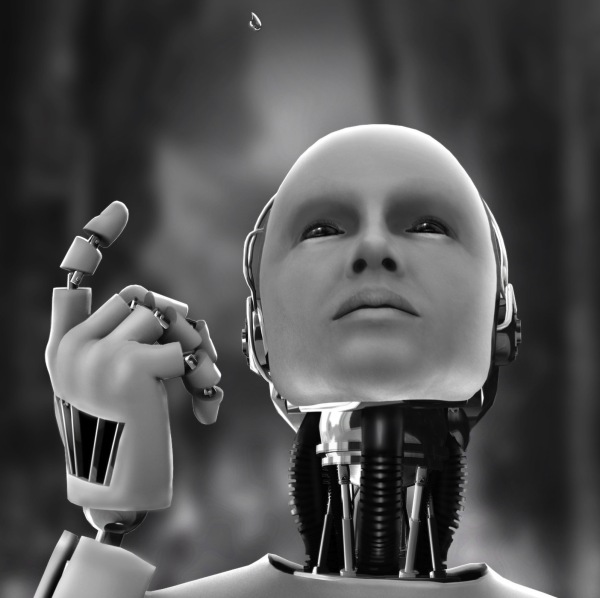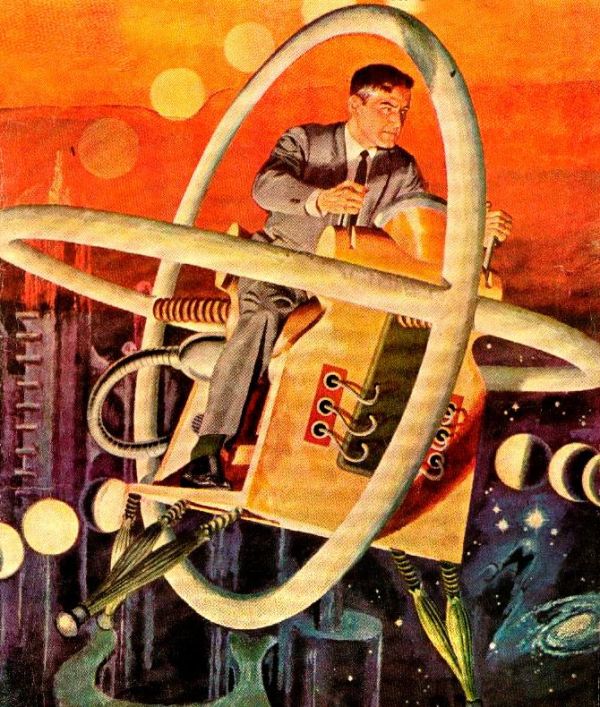FRESH AIR
From Rosie, the Jetsons’ robot maid, to Arnold Schwarzenegger’s cyborg in The Terminator, popular culture has frequently conceived of robots as having a human-like form, complete with “eyes” and mechanical limbs. But New York Times tech reporter John Markoff says that robots don’t always have a physical presence. “I have a very broad definition of what a robot is,” he tells Fresh Air’s Terry Gross. “A robot can be … a machine that can walk around, or it can be software that is a personal assistant, something like Siri or Cortana or Google Now.” Markoff, the author of the new book Machines of Loving Grace, points out that artificial intelligence plays a role in many of our lives — sometimes without our even realizing it. “I have a car that I bought this year … that is able to recognize both pedestrians and bicyclists, and if I don’t stop, it will,” he says. “That’s a very inexpensive add-on that you can get for almost any car on the market now.” Looking ahead, Markoff predicts further advances in driverless car technology. He also foresees a generation of computer chips that don’t require batteries; instead, they would run on sunlight or vibration or sweat. “In the next five years … this [computer chip] technology will fan out all around us and create applications we can’t even  think about today,” he says. “They’ll be used for robotic sensors. They’ll be made to make robots more mobile. And they’ll be used to do a million other things we can’t even conceive of, and it will continue to transform our society.” MORE
think about today,” he says. “They’ll be used for robotic sensors. They’ll be made to make robots more mobile. And they’ll be used to do a million other things we can’t even conceive of, and it will continue to transform our society.” MORE
EDGE.ORG: What hasn’t happened is the other part of the AI problem, which is called cognition. We haven’t made any breakthroughs in planning and thinking, so it’s not clear that you’ll be able to turn these machines loose in the environment to be waiters or flip hamburgers or do all the things that human beings do as quickly as we think. Also, in the United States the manufacturing economy has already left, by and large. Only 9 percent of the workers in the United States are involved in manufacturing.
There’s this wonderful counter situation to the popular belief that there will be no jobs. The last time someone wrote about this was in 1995 when a book titled The End of Work predicted this. The decade after that, the US economy grew faster than the population for the next decade. It’s not clear to me at all that things are going to work out the way they felt.
The classic example is that almost everybody cites this apparent juxtaposition of Instagram—thirteen programmers taking out a giant corporation, Kodak, with 140,000 workers. In fact, that’s not what happened at all. For one thing, Kodak wasn’t killed by Instagram. Kodak was a company that put a gun to its head and pulled the trigger multiple times until it was dead. It just made all kinds of strategic blunders. The simplest evidence of that is its competitor, Fuji, which did very well across this chasm of the Internet. The deeper thought is that Instagram, as a new?age photo sharing system, couldn’t exist until the modern Internet was built, and that probably created somewhere between 2.5 and 5 million jobs, and made them good jobs. The notion that Instagram killed both Kodak and the jobs is just fundamentally wrong. MORE
____________________
THE AFFLICTOR: In an Edge.org interview, Markoff argues that Moore’s Law has flattened out, perhaps for now or maybe for the long run, a slowdown that isn’t being acknowledged by technologists. Markoff still believes we’re headed for a highly automated future, one he senses will be slower to develop than expected. Those greatly worried about technological unemployment, the writer argues, are alarmists, since he thinks technology taking jobs is a necessity, the human population likely being unable in the future to keep pace with required production. Of course, he doesn’t have to be wrong by very much for great societal upheaval to occur and political solutions to be required.
From Markoff:
We’re at that stage, where our expectations have outrun the reality of the technology.
I’ve been thinking a lot about the current physical location of Silicon Valley. The Valley has moved. About a year ago, Richard Florida did a fascinating piece of analysis where he geo-located all the current venture capital investments. Once upon a time, the center of Silicon Valley was in Santa Clara. Now it’s moved fifty miles north, and the current center of Silicon Valley by current investment is at the foot of Potrero Hill in San Francisco. Living in San Francisco, you see that. Manufacturing, which is what Silicon Valley once was, has largely moved to Asia. Now it’s this marketing and design center. It’s a very different beast than it was.
I’ve been thinking about Silicon Valley at a plateau, and maybe the end of the line. I just spent about three or four years reporting about robotics. I’ve been writing about it since 2004, even longer, when the first autonomous vehicle grand challenge happened. I watched the rapid acceleration in robotics. We’re at this point where over the last three or four years there’s been a growing debate in our society about the role of automation, largely forced by the falling cost of computing and sensors and the fact that there’s a new round of automation in society, particularly in American society. We’re now not only displacing blue-collar tasks, which has happened forever, but we’re replacing lawyers and doctors. We’re starting to nibble at the top of the pyramid.
I played a role in creating this new debate. The automation debate comes around in America at regular intervals. The last time it happened in America was during the 1960s and it ended prematurely because of the Vietnam War. There was this discussion and then the war swept away any discussion. Now it’s come back with a vengeance.
____________________
THE AFFLICTOR: Robots may relieve us of much of the work currently monopolizing our time, which sounds great. I mean, life is too short. Unfortunately, the U.S. and many other patches on the globe don’t have economic systems capable of supporting a populace in which near-total employment isn’t the goal. Martin Ford and Andrew McAfee and Eric Brynjolfsson have written that the future is arriving too quickly and, unlike in the ’50s and ’60s, automation leading to massive technological unemployment is a real possibility. Add computer scientist and entrepreneur Jerry Kaplan, author of Humans Need Not Apply, to that list. In a lively Ask Me Anything at Reddit, Kaplan lays out his argument that a scary storm is gathering. A few exchanges follow.
____________________________
Question: Do you feel like people are too fearful of artificial intelligence?
Jerry Kaplan: The problem is that they are fearing the wrong thing. The robot apocalypse will be economic, not ‘military‘!
____________________________
Question: What is the minimum wage of an average robot? How cost-effective are they (R&D+Maintenance+Hydro etc…/X hrs. wk.)?
Jerry Kaplan: Ha interesting way to put the question. You don’t “pay” robots, of course. They are simply machines, like any others, so the question is whether the machine can perform some task in an economically advantageous way. This is a simply buy-vs-hire decision in most cases.
In my experience, it’s almost always better to use the machines, if you can afford it. Go forth and automate, my children!
____________________________
Question: With the growing increase of machines taking over manual jobs do you feel that the workplace will be made up almost entirely of machines and people will then become less focused on work and more on leisure?
Jerry Kaplan: What counts as work has shifted over the past centuries. What we do now would be considered optional “leisure” during the agrarian economy 200 years ago. They would think that our farms are made up almost entirely of machines today, and would wonder why on earth we aren’t living more simply and just enjoying ourselves!
But the desire to work is human nature. I think it’s a myth that most people just want to goof off and have fun … they’d rather work and own a fancier car! MORE


